![]()
Recent Articles

Get
all the evaluations for
the June Release
Subscribe
to Vintage Assessments today
by Clicking
Here
This
not-for-profit website is dedicated to the discerning reader!
Bringing French wine back to the fold
Gems from Southern France
National Post Weekly Wine & Spirits Columnist
Saturday, May 15, 2004
www.winefind.ca
(CLICK ON THE NAME - All listings are automatically linked to the LCBO database)
If there is a product that interests you, just click on the name below and you will instantaneously connected with the LCBO database. The product will appear in blue and all you have to do is click on the name again and then the next screen will provide details along with the store search. Just click on store search. The number of bottles in each store is updated nightly. You should call the store first to see if stock still remains (each store phone number is listed).
In
modern economics, market share is everything. Today, Australia has become
the new goliath in terms of sales - producing user-friendly, fruit-forward
wines at reasonable prices. Climate, utilization of modern technology and
absence of restrictive legislation have enabled them to displace France,
even California. And yet I can’t help but think that the continuation of
this incredible success might be a bit of an aberration.
For France, it seems that the tide seems to be receding. Few, for instance, are aware that in terms of volume, the southern French Languedoc-Rousillion region produces 10 bottles for every bottle in Australia. While some believe that Southern France has the potential of burying Australia alive; one has to ask, what is holding them back? Why are they not producing better wines?
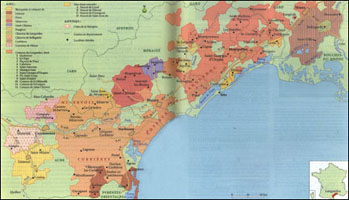
(map
from 2004 Hachette
Guide to French Wines)
-
click on the map for a large size -
First, let
us get things straight; there are plenty of well-priced, tasty wines
coming out of this region. Poor quality on LCBO shelves is the result of
the LCBO listing system, which places much more emphasis on
“investing” large sums of money into LCBO advertising programs (i.e.
Food & Drink advertising), than what is in the bottle. Only 20 points
in 100 are allocated to actual wine quality! To see the
LCBO’s amazing system for appraising new submissions click
here
Of
course, the French have to take some responsibility - restrictive French
legislation along with internal politics have hurt. It wasn’t all that
long ago that growing classic Bordeaux grape varieties was basically
banned in this region - they could not be used for prestigious appellation
contrôlée (AC) wines. In addition, producers couldn’t use grape names
on their labels.
 Today,
that has changed - even Chateau Mouton Rothschild has invested heavily in
a joint venture in the Limoux region producing a classic red called Baron’arques.
It utilizes both Mediterranean and
Today,
that has changed - even Chateau Mouton Rothschild has invested heavily in
a joint venture in the Limoux region producing a classic red called Baron’arques.
It utilizes both Mediterranean and  Bordeaux
varieties and compares favourable, qualitatively-speaking, to the best of
Bordeaux. Ironically, up until 2002, it could only be sold under the
ubiquitous Vin de Pays (VdP) status, in this case, de La Haut Vallée de
L’Aude. Those not familiar with this designation can read the notes by Tim
Atkins
as they appear in the Foreword to the Hachette
Vins de Pays – A Buyer’s Guide to the Best French Country Wines
(published by Mitchell Beazley – ISBN 1 804000 953 5) – just click
here
Bordeaux
varieties and compares favourable, qualitatively-speaking, to the best of
Bordeaux. Ironically, up until 2002, it could only be sold under the
ubiquitous Vin de Pays (VdP) status, in this case, de La Haut Vallée de
L’Aude. Those not familiar with this designation can read the notes by Tim
Atkins
as they appear in the Foreword to the Hachette
Vins de Pays – A Buyer’s Guide to the Best French Country Wines
(published by Mitchell Beazley – ISBN 1 804000 953 5) – just click
here
 I
was surprised to recently discover, for instance, that Viognier and Pinot
Noir are VdP wines (sans AC
status) or, even worse, labeled as “Vin
de Table Francais.” An example of the latter is the gorgeous Domaine
des Jougla 2000 Viognier
- it is made at Alain Jougla’s highly regarded Saint-Chinian vineyard
but not entitled to AC status. It has become so bad that many discerning
wine lovers don’t care about AC anymore.
I
was surprised to recently discover, for instance, that Viognier and Pinot
Noir are VdP wines (sans AC
status) or, even worse, labeled as “Vin
de Table Francais.” An example of the latter is the gorgeous Domaine
des Jougla 2000 Viognier
- it is made at Alain Jougla’s highly regarded Saint-Chinian vineyard
but not entitled to AC status. It has become so bad that many discerning
wine lovers don’t care about AC anymore.
In
trying to preserve tradition and terroir, French laws fossilize outdated
regulations. Key winemaking procedures permitted anywhere in the new
world, from the simple addition of acidity (to balance the wine) to the
use of French oak staves in the stainless steel tanks to provide flavour
at a reasonable cost, are outlawed. This denies winemakers the possibility
of producing better wine at reasonable prices and hurts sales. The
proliferation of new VdP sub regions only further confuses consumers.
The
problem of separating the wheat from the chaff will always exist. There
are still too many excessively filtered, flavourless, items out there -
cheap but not very cheerful. Just like Ontario’s VQA tasting panel,
minimum standards set by the French regulators are often rock bottom.
Instead of rigor, we have rigor
mortis.
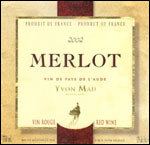 Fortunately,
some tasty, reasonably priced, southern French efforts are at the LCBO. At
a comparative blind tasting of some general list 2002 Languedoc Merlots, Yvon
Mau 2002 Merlot
(336743) at $8.45 came out on top. As the lowest in price, it is a best
buy - especially the magnum (572370 - $15.45). This VdP de L’Aude is dry
and fairly well structured with faintly earthy, plummy, tangy, red cherry
tomato flavours - great with a steak.
Fortunately,
some tasty, reasonably priced, southern French efforts are at the LCBO. At
a comparative blind tasting of some general list 2002 Languedoc Merlots, Yvon
Mau 2002 Merlot
(336743) at $8.45 came out on top. As the lowest in price, it is a best
buy - especially the magnum (572370 - $15.45). This VdP de L’Aude is dry
and fairly well structured with faintly earthy, plummy, tangy, red cherry
tomato flavours - great with a steak.
Huge
quantities of such inexpensive wines are made. This means numerous
bottlings and, by EEC law, each has a unique lot number. In the case of
Mau, the back label lot number is L4072. Be aware, however, that there can
be large swings in quality, even grape composition, from one lot to the
next. How disheartening to discover in the case of one of the pricier
Merlots that what was shipped last year was much better than what is
currently available – all the same label/vintage but different lot.
Today’s more frequent, smaller LCBO orders increase consumer exposure to
such qualitative shifts.
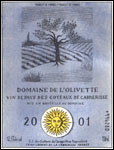 Only
Vintages and/or consignment orders show the terrific under $20 wines
available. In the Vintages May release, for instance, is a charming
organic effort (low 16 ppm free sulphur) - 2001
Domaine de l’Olivette
(996280) at $12.95. Since it contains Merlot (along with traditional Syrah
and Grenache), it is identified as a VdP Côteaux Cabrerisse (something
that nobody knows) and not an AC Bandol, where the 18th century country
house/vineyards are located! What matters is the attractive, juicy, ripe
plum nose with dried cherry notes and delightful, dry, well-balanced,
medium-light bodied, ripe plum and strawberry flavours.
Only
Vintages and/or consignment orders show the terrific under $20 wines
available. In the Vintages May release, for instance, is a charming
organic effort (low 16 ppm free sulphur) - 2001
Domaine de l’Olivette
(996280) at $12.95. Since it contains Merlot (along with traditional Syrah
and Grenache), it is identified as a VdP Côteaux Cabrerisse (something
that nobody knows) and not an AC Bandol, where the 18th century country
house/vineyards are located! What matters is the attractive, juicy, ripe
plum nose with dried cherry notes and delightful, dry, well-balanced,
medium-light bodied, ripe plum and strawberry flavours.
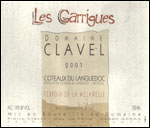 Also,
Domaine
Clavel 2001 Les Garrigues Terroir de la Mejanelle
(748814) at only $16.95 is one of my release highlights. This AC Côteaux
du Languedoc blend of 50% Syrah, 30% Grenache and 20% Carignan has a
complex, sandalwood, red licorice-tinged, plummy nose. On the palate it is
full bodied and slightly smoky with stewed ripe plum and sun dried tomato
purée flavours.
Also,
Domaine
Clavel 2001 Les Garrigues Terroir de la Mejanelle
(748814) at only $16.95 is one of my release highlights. This AC Côteaux
du Languedoc blend of 50% Syrah, 30% Grenache and 20% Carignan has a
complex, sandalwood, red licorice-tinged, plummy nose. On the palate it is
full bodied and slightly smoky with stewed ripe plum and sun dried tomato
purée flavours.
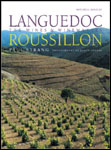 Those
want to know more about these wines should consider read Paul Strang’s
hardcover Languedoc-Roussillon:
The Wines & Winemakers.
This informative 192-page effort belongs to the Mitchell Beazley
collection and was published in 2002 (ISBN 1-84000-500-9). It is available
on the Chapters-Indigo at $42.00 (vs. $60 list) along with free shipping.
For information click
here.
Those
want to know more about these wines should consider read Paul Strang’s
hardcover Languedoc-Roussillon:
The Wines & Winemakers.
This informative 192-page effort belongs to the Mitchell Beazley
collection and was published in 2002 (ISBN 1-84000-500-9). It is available
on the Chapters-Indigo at $42.00 (vs. $60 list) along with free shipping.
For information click
here.
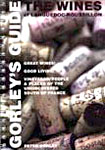 Anyone
planning to visit the region is urged to try and track down a copy of
spiral bound Gorley’s
Guide The Wines of Languedoc-Roussillon.
This outstanding effort by Peter Gorley (click
here
to see) is published in the UK by HamiltonJohnPublishing (ISBN
0-9543892-0-4) apparently is now sold out.
Anyone
planning to visit the region is urged to try and track down a copy of
spiral bound Gorley’s
Guide The Wines of Languedoc-Roussillon.
This outstanding effort by Peter Gorley (click
here
to see) is published in the UK by HamiltonJohnPublishing (ISBN
0-9543892-0-4) apparently is now sold out.
 Without
question the annual Hachette
Guide to French Wines 2004 (ISBN 1 84000 908 X) is the best
guide on the market (although, lamentably the outstanding wine from Pierre
Clavel referred to above are conspicuously absent). With over a thousand
pages, this chunky compendium is crammed full of very specific useful
buying information (over 9,000 wine recommendations). While the type is
small, the bright white pages make things tolerable. The Chapters-Indigo
website offer of a sizable 30% discount dropping the cost from $50 to $35
(click
here to see).
Without
question the annual Hachette
Guide to French Wines 2004 (ISBN 1 84000 908 X) is the best
guide on the market (although, lamentably the outstanding wine from Pierre
Clavel referred to above are conspicuously absent). With over a thousand
pages, this chunky compendium is crammed full of very specific useful
buying information (over 9,000 wine recommendations). While the type is
small, the bright white pages make things tolerable. The Chapters-Indigo
website offer of a sizable 30% discount dropping the cost from $50 to $35
(click
here to see).
2001-2002-2003-2004 Tasting Note Database
Our tasting note database from December 31, 2000 to April 2004, covers every Vintages release product for the past 40 months. There are more than 6,000 notes in the database data. Just enter the name of the product, supplier name or CSPC number. Or you can search by type of wine, country of origin, even wine agent! Nothing could be easier. Also you can get information on the agent by clicking on the agent’s name, as well as current LCBO store inventory by clicking on "Check LCBO Availability", which will automatically tell you the number of bottles at LCBO as of last night.
To use our winefind.ca Tasting Notes Database: click here
Subscribe to Vintage Assessments Today • Click Here
|
** For All Visitors ** |
Check out the
June
2004 InStore Discovery
Copyright Food
& Beverage Testing Institute of Canada
2004
Prior written permission is required for any form of reproduction
(electronic or other wise) and or quotation.
Contact Michael Vaughan at
mbv@total.net